Table of Contents
Various Types of Level Used In Building Construction
Various types of levels are used in AutoCAD drawings, and they are used to ease understanding. The different types of levels used in building construction are as follows.
- Natural Ground Level (NGL)
- Ground Level (GL)
- Existing Ground Level (EGL)
- Plinth Level
- Sill Level
- Lintel Level
- Floor Finish Level (FFL)
- Structural Floor Level (SFL)
- Structural Slab Level (SSL)
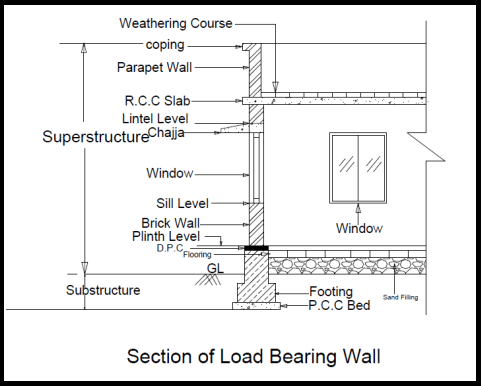
What is Natural Ground Level(NGL)?
NGL is the abbreviation of the natural ground level. It is the natural level of ground before any filling or excavation. Generally, Its height is measured from the mean sea level.
What is Ground Level?
GL and FL are the abbreviations used for Ground Level and Floor level, respectively.
The term ground level refers to the building’s level at the ground or nearest to the ground level around it. Or
The level located above the external road and below the finished floor level is termed ground level.
The term story refers to all the levels of the building found over the ground level.
The term FGL Finish ground level refers to the ground that has been finished with tiles, grass, paver blocks, landscaping, or other means.
What is the Existing Ground Level?
EGL stands for existing ground Level; it is the existing ground level, whether in the cutting or filling stage, known as existing ground level.
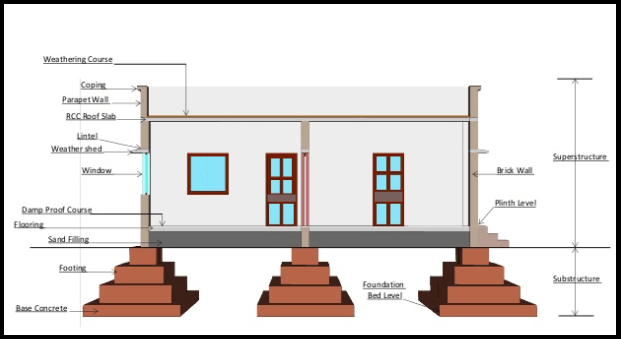
What is Plinth Level?
A-Level where the substructure ends and the superstructure starts is known as the plinth level. The plinth is a part of the superstructure located between the ground level and the finished floor level.
The plinth helps in transferring the superstructure’s load to the foundation. It also offers safety to the building against penetration of moisture and a good architectural appearance.
The primary purpose of providing a plinth is to prevent the entry of rainwater and stormwater into the building. The damp proof course is also offered at the top of the plinth, which helps stop moisture movement through walls.
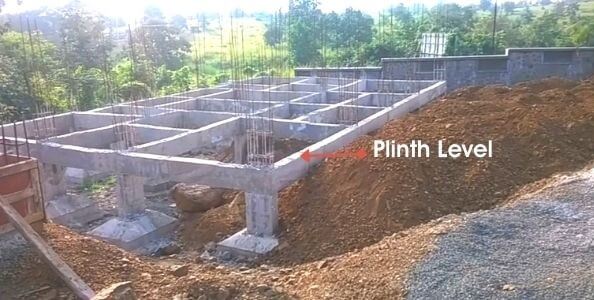
The plinth height should be between 150 mm to 450 mm from the ground level. The minimum required height of the plinth should be 150 mm from the road.
Importance of plinth Beam
- It carries a dead load of brick masonry constructed over it.
- It helps to transmit a load of superstructure to the foundation.
- It helps to protect the structure from moisture and dampness.
- It helps to retain the backfill material, acts as a retaining wall.
- It helps to lower the differential settlement risk of the foundation.
- It helps to enhance a building’s aesthetic appearance.
- It also helps to keep columns and walls connected by acting as a tie beam.
Also, Read – What is Plinth Beam? Plinth Protection, Difference Between Plinth Beam and Tie Beam.
What is Sill Level?
It is the height up to the window base, measuring from the building’s floor level to the window base upward. Or
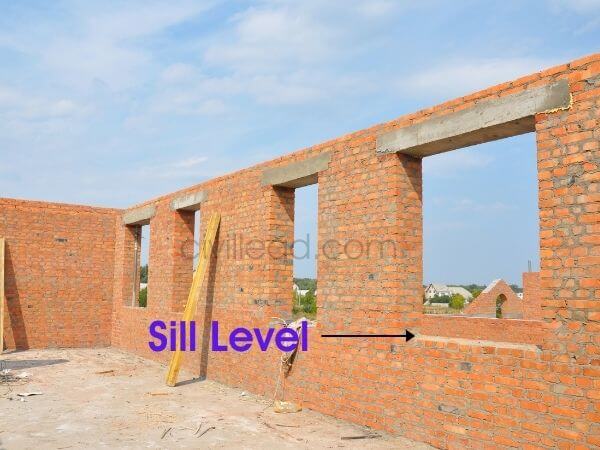
A level between the building’s window base and floor level above ground level is known as the sill level. The concrete bed or mortar bed is placed at the window base level. Granite is also used at the base level of the window.
Sill level height varies from room to room and depends on the room type. For bedrooms generally, a height of 1100 mm is adopted due to privacy while in the drawing-room, commonly height 600-650 is provided.
The minimum required height of the sill level should be 44 inches.
Also, Read – Difference Between One way and Two-way Slab
What is Lintel Level?
The height measured from floor level above the ground to the window top-level refers to the lintel level. Or level above the window is known as lintel level. or A level at which the door and window top are finished is called lintel level.
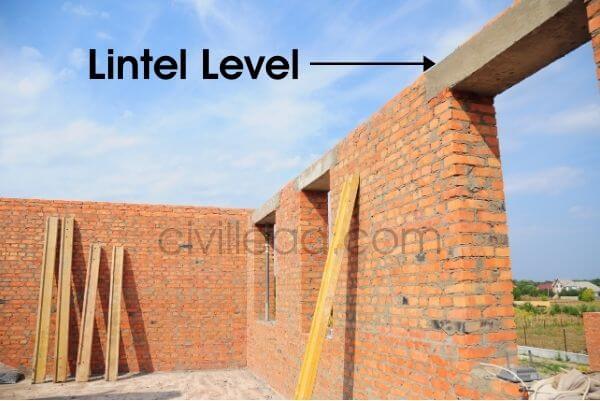
A lintel is a horizontal member placed across an opening to support the part of the structure. It gives bearing for the masonry above the opening and transfer all the loads acting over the opening to the supporting walls.
Mostly RCC lintel is used, but there are other types of lintel like Wooden, stone, Brick is used as per suitability.
Door and window frames are not capable enough to bear the load masonry above the opening. Therefore a separate structural element is provided to overcome this issue, which is known as a lintel.
Also, Read – Difference Between OPC and PPC Cement
What is Finished Floor Level?
The building’s inner floor is finished with tiles, marble, granite, or other means; after that, no further finishing work is needed, known as the finished floor level.
Generally, FFL is 150 to 450 mm above the natural ground level so that rainwater and stormwater do not enter inside the building.
If the building is located in a massive rainfall area and slope, this height may go up to meters.
What is Structural Floor Level?
The term SFL, full form Structural floor level, refers to the concrete topping or floor screeding’s top surface level. Generally, there is a 50 mm difference between SSL and FFL.
What is Structural Slab Level?
The term SSL stands for structural Slab level refers to the top surface level of the structural slab.
This term is mostly used in the commercial and industrial markets. The term SSL is used when another finishing is going to be placed over the structural slab.
Both terms SSL and SFL are the same. Generally, Term SSL is used in structural drawing, while SFL is used in architectural drawing.
Also, Read – What is Concrete Cover? Clear Cover, Nominal Cover and Effective Cover
Difference Between Plinth Level, Sill Level and Lintel Level
| S.No. | Plinth Level | Sill Level | Lintel Level |
|---|---|---|---|
| 1 | A part of the superstructure is Located Between the Finished floor level and ground level. | Also, a part of the superstructure is located between the window and the building floor. | A lintel is a structural member that is provided above the opening ( door, window). And height up to this from floor level is known as lintel level. |
| 2 | The plinth is provided to act as a barrier against rainwater and stormwater to support a dead load of masonry above it. | Sill is provided to give a uniform base for the window. | A lintel is provided to carry the load of masonry above the opening. |
| 3 | The plinth is generally constructed with RCC. | Sill is constructed with RCC or cement mortar. Granite is also used as a sill. | A lintel may be of RRC, Stone, steel, wooden, and Brick. Generally, RCC lintel is used. |
| 4 | Usually, the plinth height between 300 to 450 mm above the ground level is taken. | Generally, the sill’s height for bedroom 1100 mm and 600-650 mm for the drawing-room is adopted. | While the height for sill is 2130 mm (7′) in residential and 2316 mm (7’6″) in commercial in most of the cases. |
I hope now you understood the difference between plinth level, sill level and lintel level. if you find this information helpful please share it with your friends.
Thanks!
Also, Read
Difference Between Beam and Lintel.
Grade Beam – Grade Beam Foundation, Construction process, Advantages & Disadvantage
What is the Plinth area? – Calculation, Plinth Area Estimate
What is Pointing? Types of Pointing, Purpose, Method.
How to Calculate Cement, Sand, Aggregate and Water quantity for concrete mix ratio?
Concrete Mix Ratio – Types, Proportioning of Concrete Mix and Methods
Grade of Concrete and Their Uses
What is BOQ? – Purpose, Importance, Advantages and Disadvantage